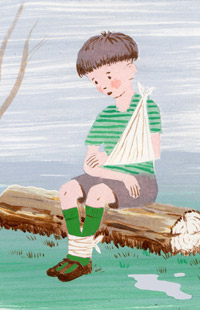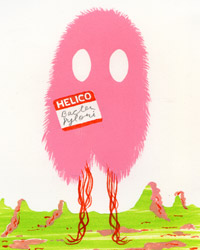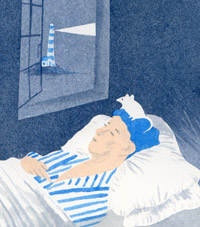FALL 2011 CONTENTS
Home
Game Change
On the verge of a revolution
Inside the labs
Highlighting recent Stanford cancer research
Cancer's biographer
A conversation with Siddhartha Mukherjee
The unexpected
Cancer during pregnancy
After cancer's cured
What's left to heal?
Make your own cancer diagnostic test
It's easier than you think

DOWNLOAD PRINTABLE
ISSUE (PDF)

Hard knocks
Brian Cronin
New research has shown that children's risk for learning and behavior problems and obesity rises in correlation to their level of trauma exposure, says the psychiatrist at the School of Medicine and Lucile Packard Children’s Hospital who oversaw the study.
The findings could encourage physicians to consider diagnosing post-traumatic stress disorder rather than attention deficit/hyperactivity disorder, which has symptoms similar to PTSD but very different treatment.
“Contrary to some people’s belief, children don’t get used to trauma. These events remain stressful and impact children’s physiology,” says senior author Victor Carrion, MD, associate professor of psychiatry and behavioral sciences.
The study was published online June 8 in Child Abuse & Neglect: The International Journal.
The findings provide compelling evidence that pediatricians should routinely screen children for trauma exposures, says Carrion, who is also a child psychiatrist at Packard Children’s. “As simple as it may seem, physicians do not ask about trauma,” he says.
The study builds on earlier work that linked worsening health in adults with their dose of exposure to nine types of adverse childhood events, including being subject to various kinds of abuse or neglect; having a household member who abused alcohol or drugs, was incarcerated or was mentally ill; having a mother who was treated violently; and not living in a two-parent household.
To perform the study, the researchers evaluated medical records from 701 children treated at a primary-care clinic in Bayview-Hunter’s Point, a San Francisco neighborhood with high rates of poverty and violence. Each child’s exposure to adverse events was scored on a scale from 0 to 9, with one point given for each type of adversity. The researchers also evaluated the medical records for evidence of obesity and learning or behavior problems.
Adverse Effects
Two-thirds of the children had experienced at least one category of adversity, and 12 percent experienced four or more categories. An adversity score of 4 or higher left kids 30 times as likely to show learning and behavior problems and twice as likely to be obese as those with a score of 0.
Prior research has shown that about 30 percent of children in violent communities have symptoms of post-traumatic stress disorder, which can include the learning and behavior problems detected in the current study, Carrion notes. However, a physician unaware that a child had experienced trauma, and noting the child’s physiological hyperarousability and cognitive difficulties, may diagnose ADHD instead of PTSD. That’s a problem because the two disorders have opposite treatments, he says. Kids with PTSD need psychotherapy, not the stimulant medications given for ADHD.
“Children can recover from PTSD with the appropriate treatment, which is one of approach and not avoidance,” Carrion says. “By not asking about trauma, we’re utilizing avoidance. We’re perpetuating PTSD.”
It’s important to expand access to psychotherapy, even if only short-term, for impoverished children with PTSD, says Carrion. He’s working with collaborators and community partners in San Francisco to launch the Center for Youth Wellness, combining pediatrics, mental health services, educational support, family support, research and child-abuse response. It’s set to open by mid-2012. — Erin Digitale
The research was funded by the Lennar Urban Corp., the National Institute of Mental Health and the Evans Foundation.
Autism redux
A new School of Medicine study of twinssuggests that non-genetic factors play an unexpectedly large role in determining autism risk, turning upside down recent assumptions about the cause of this common, disabling developmental disorder.
From prior studies of shared autism in twins, scientists had estimated that 90 percent of autism risk was attributable to genes and only 10 percent to non-genetic environmental factors. But the new study — the largest ever of twins in which at least one in each pair has autism — shows almost the opposite: It found that genes account for 38 percent of autism risk, with environmental factors explaining the remaining 62 percent.
“It took me a bit by surprise that the heritability of autism was so much lower than previous studies calculated,” says Joachim Hallmayer, MD, associate professor of psychiatry and behavioral sciences and first author of the new paper, which appeared in the July 4 issue of Archives of General Psychiatry. “Our work suggests that the role of environmental factors has been underestimated.”
Although the study does not identify specific environmental factors, they could include any non-genetic factors that influence autism risk.
The children studied were 192 pairs of twins identified from a California-wide registry of children who receive services for developmental disabilities. The large size of the study and the fact that the subjects were drawn from California’s entire, highly diverse population means the study’s results are more reliable and apply more broadly than those from prior studies, which examined small, homogeneous groups of children in Northern European countries, Hallmayer says.
The study included 54 pairs of identical twins and 138 pairs of fraternal twins. At least one child from each pair had been diagnosed with full-blown autism or a less severe form of autism spectrum disorder. The scientists conducted standardized evaluations to verify the children’s diagnoses, a step that had been omitted in many prior studies.
Scientists had estimated that 90 percent of autism risk was attributable to genes. The new study found that genes account for 38 percent of autism risk, with non-genetic factors explaining the remaining 62 percent.
To calculate the relative contributions of genes and environment to autism risk, the researchers then examined the difference in shared autism rates between identical and fraternal twins. Identical twins share all their genes, fraternal twins share half of theirs, and both types of twins share most elements of their environment from conception through childhood. As the scientists expected for a disease that is partly explained by genes, the identical twins were more likely to share an autism diagnosis than the fraternal twins. Identical twins did not always share their diagnosis, hinting that non-genetic factors contribute to autism. The surprise came, however, in the calculation of environmental contributions to autism risk.
“The dizygotic [fraternal] twins are more similar than you would expect if you take only genetic factors into account,” Hallmayer says. The higher-than-expected degree of similarity between fraternal twins confirmed that something other than genes was at work — in other words, the twins’ shared environments helped explain their shared diagnoses.
And what might the unknown environmental risk factors be? “That’s the multimillion dollar question,” Hallmayer says. — Erin Digitale
The research was funded by the National Institute of Mental Health and Autism Speaks.
Jittery bugs
Brian Cronin
If you were the size of a bacterium,the lining of a stomach would seem like a rugged, hilly landscape filled with acid-spewing geysers, says Manuel Amieva, MD, PhD, assistant professor of pediatrics and of microbiology and immunology.
Helicobacter pylori, the bacterium that causes ulcers and some cancers, must navigate through the treacherous terrain to find sanctuary in the mucous layer that coats the inside of the stomach. In a study published in mBio on July 26, Amieva and others identified a protein that regulates H. pylori’s ability to seek slimy shelter. That protein could be a target for therapies that specifically combat H. pylori while leaving our friendly gut bacteria alone.
H. pylori makes a living in about half the people on Earth and typically goes unnoticed. But in about 15 percent of those infected, the microbes cause ulcers. Yet worse, H. pylori infection increases the risk of gastric cancer.
Although it takes up residence in our stomachs, H. pylori can’t stand our caustic digestive juices. To avoid getting burned, the microbes use whiplike appendages called flagella to power their corkscrew bodies into the mucus that protects our stomach cells. While it was known that the bacteria colonize the stomach’s surface mucus, the School of Medicine researchers found that they also live deep in some of the glands that tunnel down from the stomach’s inner surface.
A protein called ChePep helps the bugs find their way into safe areas, the researchers discovered. Without it, the bacteria behaved erratically, doing a lot more backward swimming than normal, as if always trying to escape toxic conditions.
“They weren’t taking the nice arcing trajectories that you see with normal H. pylori; they were moving herky jerky, taking short swims, then stopping, then turning and swimming off again,” says lead author Michael Howitt, PhD, a former graduate student in Amieva’s lab.
Microbes use their so-called chemotaxis machinery to move based on the chemical composition of their surroundings, swimming toward good conditions and away from bad.
“If the bacterium isn’t sensing anything bad, it’ll rotate the flagella in one direction and swim straight,” says Amieva, senior author of the study. “But if something bad is seen, it’ll activate a clutch, stall the flagella and switch directions.” The newly discovered ChePep helps regulate when that clutch gets activated.
The researchers were surprised to find an unknown part of the chemotaxis machinery. “The chemotaxis system is the best-studied biochemical signaling system ever. Finding a new player was totally unexpected,” says Amieva.
While most components of the chemotaxis machinery are shared in all bacterial families, ChePep is unique. Its uncommon nature means ChePep could be a good drug target for fighting H. pylori. “If you blocked ChePep, the beneficial bacteria in our guts would still have their chemotaxis machinery intact,” says Howitt. —Susan L. Young
The work was supported by the National Institutes of Health, the National Cancer Institute and the National Institute of Allergy and Infectious Diseases.
Sleep interrupted
Brian Cronin
Getting roused from a good snooze, is not only bad for your mood, it could be bad for your memory, according to a new study in mice.
Experts have long hypothesized that sleep continuity is important for memory, but it has been difficult to investigate, in part because a preferred research subject — the mouse — is so jumpy. Once you wake a mouse up, it gets stressed (which itself affects memory), and it doesn’t fall back asleep for a long time.
In addition, any kind of sleep manipulation affects all features of the sleep — not only continuity but also duration, quality and percentage of rapid eye movement sleep, explains Luis de Lecea, PhD, associate professor of psychiatry and behavioral sciences, who co-led the study with H. Craig Heller, PhD, professor of biology.
So the researchers’ challenge was this: How could they fragment sleep into shorter episodes without affecting sleep intensity or duration and without invoking a stress response, so they could see its effects on memory?
The challenge: How could they fragment sleep into shorter episodes without affecting sleep intensity or duration and without invoking a stress response, so they could see its effects on memory?
They turned to optogenetics, a technique in which specific cells are genetically engineered to be controlled by pulses of visible light. The researchers used the method on the type of neurons that play a key role in switching between sleep and wake, and found that by stimulating these cells with 10-second bursts of light, they could fragment the animals’ sleep without affecting total sleep time or quality and composition of sleep.
After manipulating the mice’s sleep, the researchers tested their memories. They presented the mice with two objects: one that they had seen before, and another that was new. Rodents’ natural tendency is to explore novel objects, so if they spent more time with the new object, it would indicate that they remembered the other, now familiar object.
The result: Mice with fragmented sleep explored the novel object no longer than the familiar one, showing that their memory was affected.
While the study does not reach any conclusions about the amount of sleep needed to avoid memory impairment in humans, it does suggest that memory difficulties in people with apnea and other sleep disorders are likely connected to the compromised continuity of sleep caused by such conditions.
The findings were published online July 25 in the Proceedings of the National Academy of Sciences. — Michelle L. Brandt
The study was funded by the National Institute of Mental Health and the Klarman Family Foundation.
New digs
Stanford University Medical Centerhas begun laying the groundwork for its much-anticipated, $3 billion renewal project, which will bring new state-of-the-art patient care and research facilities to the community.
The six- to seven-year renewal project includes construction of a new Stanford Hospital and laboratories at the School of Medicine, and the expansion of Lucile Packard Children’s Hospital.
“At the heart of the project is the hospitals’ and medical school’s need to deliver rapidly advancing medical science to a growing community of patients and providers in the safest, most future-thinking and seismically sound environment,” says Mark Tortorich, vice president of planning, design and construction for the hospitals.
Site preparation work began this summer. One of the first projects is an upgrade to the Hoover Pavilion on Quarry Road. Originally built in 1930 as the Palo Alto Hospital, the site today houses outpatient and administrative offices and the Arboretum Children’s Center. The building will be modernized and improved, yet preserved through a facelift so it will better resemble its historic image. A new parking garage will also be added to the site.
On Welch Road, major utility upgrades are being made for the new buildings. Water services, gas lines and information technology infrastructure — located under Welch Road between Pasteur Drive and Quarry Road — will be replaced over the next 18 to 24 months. Welch Road will then be repaved, with a center-turn lane and new bicycle lane. The landscape and median strips will be improved, benefitting all the Welch Road buildings.
Packard Addition
This fall, demolition of the buildings at 701 and 703 Welch Road will clear ground for the addition to Packard Children’s Hospital, which will add 104 beds to the hospital’s capacity. In early 2012, utility lines that serve the current Packard Children’s Hospital — which, like Stanford Hospital, will continue to care for patients throughout the renewal process — will be redirected to make way for construction, which will take about 18 months. By the fall of 2012, says Tortorich, “you’ll begin to see a large hole in the ground” as excavation begins for the addition to the children’s hospital. The underground parking structure and floors will be built first, then the above-ground work will become visible, with steel framework scheduled to rise in summer 2013. Construction is expected to be completed by 2016.
At the medical school, the 1959 Edwards, Lane and Alway buildings, which do not meet current seismic standards, will be replaced with three laboratory buildings to be called the Foundations in Medicine buildings. Construction for the first FIM structure is scheduled to begin April 2013 with occupancy scheduled for July 2015.
At Stanford Hospital & Clinics, some facilities and services currently at 1101 Welch Road will be moved into the renovated Hoover Pavilion to help prepare for construction, Tortorich says. The Welch Road building and the Blake Wilbur parking structure then will be removed and prepared as the site of the new Stanford Hospital.
Shovels will go into the ground in the beginning of 2013 with steel framework for the new, 600-bed Stanford Hospital to go up in August 2014. The new hospital, including an enlarged and enhanced emergency department, will be completed in 2017, with planned occupancy the following year. — Julie Greicius


